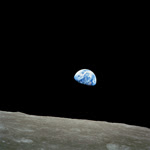
Christmas, 37 years ago: I was 16, and I was more than usually excited about the holiday. Since the launch four days earlier (on December 21), I had been avidly following all the available news on the Apollo 8 mission, with astronauts Frank Borman, James A. Lovell Jr., and William A. Anders. I could hardly believe that I was living through a time when men were actually travelling away from Earth. What a moment in history!
It’s probably difficult for many people — especially those not old enough to remember those days — to imagine just how daring and amazing Apollo 8 was. No human had ever ventured more than a few hundred miles from the surface of the Earth before, and now these three were going about a quarter Bomillion miles away! I was also afraid for them, even with my then very lightweight understanding of just how risky that voyage was. The astronauts had a good ship, the best that we could give them — but our technology was far less capable then than it is today. Looking back, across decades of technological improvement and my own greater understanding of engineering, I am even more amazed at the audacity of this mission. Those were three very brave men…
From Apollo 8 Man Around the Moon, part of the online Apollo 8 Journal:
It was Christmas time, 1968, when man broke his bonds to Earth. Three Americans, Frank Borman, James A. Lovell Jr., and William A. Anders, guided their Apollo 8 spacecraft across nearly a quarter-million miles of black void, out of the grasp of Earth, into orbit around the Moon, and back once more to a chosen pinpoint on their home planet.
Never before had man traveled so far, so fast or looked so closely upon another celestial body. Never before had so many millions listened and watched, their imaginations stretched, as the explorers spoke across the emptiness. Never, indeed, had adventure ever borne all mankind so daringly near the boundaries of its aspirations.
What the astronauts saw of the Moon, from 70 miles above that foreboding surface, can now be seen by all and studied by scientists in the array of still and motion pictures, many of them in color, taken from Apollo 8. What the astronauts succeeded in proving about the reliability of the spacecraft and its rocket vehicle confirmed that some day soon men will actually set foot upon the Moon.
It was the first time that men had been launched into space by the Saturn V, America’s most powerful machine. It was the first time, too, that men had sped at nearly 25,000 miles an hour, as Apollo 8 hurled itself from orbit of the Earth and into flight toward the Moon.
Each time Astronauts Borman, Lovell, and Anders vanished behind the far side of the Moon they lost all contact with the Earth for 45 minutes on each of the 10 orbits. During the first long silence the black void crackled with tension until Mission Control in Houston reported, “We’ve got it! Apollo 8 is in lunar orbit."
"Good to hear your voice,” said Astronaut Lovell.
On the Eve of Christmas, as the eyes of the world followed Apollo 8 across the moonscape, the astronauts invoked another, older voice, reading in turn the first ten verses of Genesis, the Story of Creation. Its conclusion, “…and God saw that it was good” echoed in Astronaut Borman’s words as again Apollo 8 headed into the silent, tantalizing absence of earthly communications:
"God bless all of you — all of you on the good Earth."
The famous image at above right, along with the astronauts' recitations described above, are what most people remember about Apollo 8 (if they remember it at all). While we could hear the reading of Genesis in realtime, the picture at right wasn’t available until months after the mission — for it was taken on plain old-fashioned silver halide film, with a Hasselblad 70mm camera. There was no such thing, back then, as “digital cameras” — and absolutely no way to get a high resolution image like this back to Earth across the void between the Moon and the Earth. No, we had to wait until Borman, Lovell, and Anders carried that film back home…
Just 7 months and three Apollow missions later, in July 1968, Apollo 11 landed on the moon. Those were heady times for anyone interested in the space program. We felt like we were living in a science fiction novel…
As usual, click on the picture at right for a (much) larger version…
